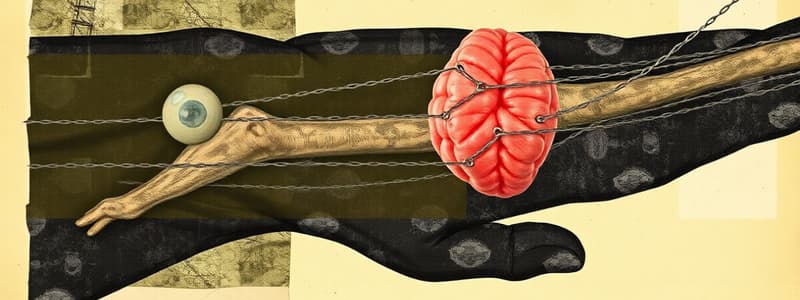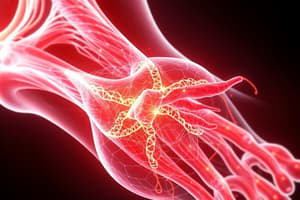Podcast
Questions and Answers
During which phase of tendon healing do fibroblasts align parallel to the lines of force applied to the tissue?
During which phase of tendon healing do fibroblasts align parallel to the lines of force applied to the tissue?
- Inflammatory
- Proliferative (correct)
- Remodeling
- None of the above
What is the primary characteristic of the inflammatory phase in both tendon and ligament healing?
What is the primary characteristic of the inflammatory phase in both tendon and ligament healing?
- Removal of damaged tissue by phagocytic cells (correct)
- Orientation of collagen along lines of stress
- Collagen maturation and alignment
- Fibroblast proliferation and extracellular matrix production
Which of the following is NOT a characteristic of the remodeling phase of tendon healing?
Which of the following is NOT a characteristic of the remodeling phase of tendon healing?
- Phases happen at the same time in different places of the tissue and overlap
- Collagen content increases
- Collagen matures and assumes functional linear alignment
- Fibroblasts align parallel to lines of force (correct)
What is the PRIMARY difference between the proliferative phases of tendon and ligament healing?
What is the PRIMARY difference between the proliferative phases of tendon and ligament healing?
How long does the inflammatory phase typically last in ligament healing?
How long does the inflammatory phase typically last in ligament healing?
Why is there no spontaneous healing in the avascular zone of fibrocartilage?
Why is there no spontaneous healing in the avascular zone of fibrocartilage?
Which of the following statements about the remodeling phase in ligament healing is TRUE?
Which of the following statements about the remodeling phase in ligament healing is TRUE?
Which of these tissues DOES NOT have a distinct inflammatory phase in its healing process?
Which of these tissues DOES NOT have a distinct inflammatory phase in its healing process?
What is the primary characteristic of the proliferative phase of articular cartilage healing?
What is the primary characteristic of the proliferative phase of articular cartilage healing?
Which of these is NOT a characteristic of indirect fracture healing?
Which of these is NOT a characteristic of indirect fracture healing?
What is the significance of the recruitment of mesenchymal stem cells (MSCs) during the inflammatory phase of indirect fracture healing?
What is the significance of the recruitment of mesenchymal stem cells (MSCs) during the inflammatory phase of indirect fracture healing?
Which of the following is NOT a characteristic of the remodeling phase of indirect fracture healing?
Which of the following is NOT a characteristic of the remodeling phase of indirect fracture healing?
During which phase of articular cartilage healing does the matrix primarily consist of type II collagen, proteoglycans, type I collagen, and non-collagenous proteins?
During which phase of articular cartilage healing does the matrix primarily consist of type II collagen, proteoglycans, type I collagen, and non-collagenous proteins?
Which type of fracture healing requires intimate contact of the fractured ends?
Which type of fracture healing requires intimate contact of the fractured ends?
What is the primary difference between chondral and osteochondral injuries in terms of healing potential?
What is the primary difference between chondral and osteochondral injuries in terms of healing potential?
During which phase of indirect fracture healing does angiogenesis occur?
During which phase of indirect fracture healing does angiogenesis occur?
Which of the following processes does NOT contribute to the formation of a soft callus during the reparative phase of indirect fracture healing?
Which of the following processes does NOT contribute to the formation of a soft callus during the reparative phase of indirect fracture healing?
Which stage of indirect fracture healing peaks at approximately 7-9 days post-trauma?
Which stage of indirect fracture healing peaks at approximately 7-9 days post-trauma?
Flashcards
Tendon Healing Phases
Tendon Healing Phases
Stages of healing in tendons: Inflammatory, Proliferative, Remodeling.
Inflammatory Phase of Tendon Healing
Inflammatory Phase of Tendon Healing
First phase (~1 week) where macrophages clean damaged tissue and granulation tissue forms.
Proliferative Phase of Tendon Healing
Proliferative Phase of Tendon Healing
Middle phase (~1-5 weeks) where fibroblasts align parallel, collagen increases.
Remodeling Phase of Tendon Healing
Remodeling Phase of Tendon Healing
Signup and view all the flashcards
Ligament Healing Phases
Ligament Healing Phases
Signup and view all the flashcards
Inflammatory Phase of Ligament Healing
Inflammatory Phase of Ligament Healing
Signup and view all the flashcards
Proliferative Phase of Ligament Healing
Proliferative Phase of Ligament Healing
Signup and view all the flashcards
Fibrocartilage Healing
Fibrocartilage Healing
Signup and view all the flashcards
Phases of Wound Healing
Phases of Wound Healing
Signup and view all the flashcards
Chondral Injury
Chondral Injury
Signup and view all the flashcards
Osteochondral Injury
Osteochondral Injury
Signup and view all the flashcards
Indirect Fracture Healing
Indirect Fracture Healing
Signup and view all the flashcards
Direct Fracture Healing
Direct Fracture Healing
Signup and view all the flashcards
Inflammatory Phase of Healing
Inflammatory Phase of Healing
Signup and view all the flashcards
Reparative Phase
Reparative Phase
Signup and view all the flashcards
Remodeling Phase
Remodeling Phase
Signup and view all the flashcards
Role of MSCs
Role of MSCs
Signup and view all the flashcards
Healing Time for Bones
Healing Time for Bones
Signup and view all the flashcards
Study Notes
Tissue Healing Mechanisms and Timelines
-
Tendon Healing:
- Inflammatory Phase (~1 week): Macrophages clear damaged tissue, new blood vessels (capillaries) and fibroblasts proliferate, laying down new tissue. Fibroblasts initially align perpendicular to the tendon's fibers, followed by the parallel alignment that aligns with directional forces.
- Proliferative Phase (~1-5 weeks): Fibroblasts align parallel to the direction of the tendon's forces. Collagen content dramatically increases in the collagen fibers.
- Remodeling Phase (~2-4 months): Collagen matures and assumes functional alignment, ultimately becoming suited to the stresses placed on the tendon. Phases overlap and occur concurrently in different parts of the tissue.
-
Ligament Healing:
- Inflammatory Phase (~5 days): Phagocytic cells remove injured tissues. Chemicals are released to stimulate fibroblast activity.
- Proliferative Phase (~Day 5 – Week 6): Fibroblasts multiply, producing extracellular matrix and collagen. Initially, collagen is immature and randomly organized, but develops sufficient strength (to resist forces) within 2-3 weeks. Normal collagen levels are reached by week 6.
- Remodeling Phase (~4+ weeks): Collagen reorganizes along stress lines. The structure becomes more organized to withstand more significant stress.
-
Fibrocartilage (Meniscus) Healing:
- Inflammatory and Proliferative (~ up to 10 weeks): No spontaneous healing in the avascular zone (no blood supply). Within the vascular zone, fibrin clot formation and macrophage activity occurs to clear damaged tissue. Undifferentiated mesenchymal cells migrate, proliferate and fill the lesion with fibrovascular scar tissue.
- Remodeling Phase (~Weeks 10+): Remodeling to the normal meniscal structure takes several months.
-
Articular Cartilage Healing:
- Chondral vs. Osteochondral Injuries: Chondral (cartilage alone) injuries rarely heal due to lack of blood vessels (avascular). Osteochondral injuries (involving underlying bone) might heal due to the proximity of blood vessels in the bone.
- Inflammatory Phase (~0-2 weeks): Blood vessels from the bone defect extend into cartilage forming a fibrin clot. Undifferentiated mesenchymal cells migrate and form new tissue matrices.
- Proliferative Phase (~2-6 weeks): Matrix composition includes type II collagen, proteoglycans, type I collagen, and non-collagenous proteins.
- Remodeling Phase (~6+ weeks): Forms a structure between fibrocartilage and hyaline cartilage. However, long-term healing may not completely recover and show proteoglycan depletion and cartilage damage over time.
-
Bone Healing:
-
Types of Fracture Healing:
- Indirect (Secondary): Most common, no precise anatomical reduction needed, heals via micro-motion and weight-bearing.
- Direct: Requires precise anatomical reduction, tight contact of bone ends, and rigid stability.
-
General Stages:
- Inflammatory: Hematoma formation, macrophage activity, angiogenesis (blood vessel formation). Mesenchymal Stem Cells are recruited. (Duration: ~0-7 days, peak in 24 hours)
- Reparative: Soft callus formation (cartilage and periosteal), vascularization, mineralisation and conversion to hard callus. (~7-14 days)
- Remodeling: Hard callus resorption, formation of lamellar bone, and medullary cavity formation. (Duration: Several weeks to years depending on size and location of the fracture) Stimulated by piezoelectric effect (pressure-induced electrical polarity).
-
Healing Time:
- Small bones: 3-6 weeks
- Large bones: 8-12 weeks (children and adults, roughly)
-
Studying That Suits You
Use AI to generate personalized quizzes and flashcards to suit your learning preferences.



